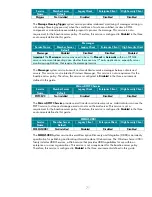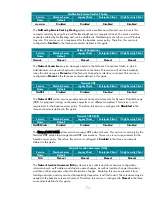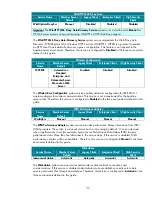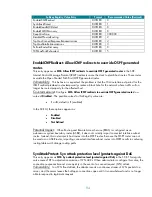
82
is by providing specific administrator information; an example of a two-factor authentication including
this type would be requiring users to submit to a retina scanner followed by entering their passwords
before granting them access to restricted resources. Using smart cards to implement multifactor
authentication is a best practice and is employed for all administrator accounts. If the company
organization utilizes smart card authentication, this service needs to be set to
Manual
.
SNMP Service
Service Name
Member Server
Default
Legacy Client
Enterprise Client High Security Client
SNMP Not
installed Disabled Disabled Disabled
Important:
The
SNMP Service
must be set to
Automatic
on HP NAS server systems requiring SNMP
support. For example, HP Insight Manager software uses and requires SNMP. Customers using HP
Insight Manager software within their HP NAS systems should set this setting to
Automatic.
The
SNMP
Service
allows incoming SNMP requests to be serviced by the local computer. The
SNMP
Service
includes agents that monitor activity in network devices and report to the network console
workstation. There are no requirements or dependencies in the three environments for the
SNMP
Server.
Therefore, this service is configured to
Disabled
in the three environments defined in this
guide.
SNMP Trap Service
Service Name
Member Server
Default
Legacy Client
Enterprise Client High Security Client
SNMPTRAP Not
installed Disabled Disabled Disabled
Important:
The
SNMP Trap Service
must be set to
Automatic
on HP NAS server systems requiring
SNMP trap support. For example, HP Insight Manager software uses and requires SNMP trap
support. Customers using HP Insight Manager software within their HP NAS systems should set this
setting to
Automatic.
The
SNMP Trap Service
receives trap messages generated by local or remote SNMP agents and
forwards the messages to SNMP management programs running on the computer. This service is not
a requirement for the baseline server policy. Therefore, this service is configured to
Disabled
in the
three environments defined in this guide.
Special Administration Console Helper
Service
Name
Member Server
Default
Legacy Client
Enterprise Client
High Security Client
Sacsvr Manual Disabled Disabled Disabled
The
Special Administration Console Helper
system service (SAC) performs remote management tasks if
any of the Windows Server 2003 family of operating systems stops functioning due to a Stop error
message. This service is not a requirement for the baseline server policy. Therefore, this service is
configured to
Disabled
in the three environments defined in this guide.
















































